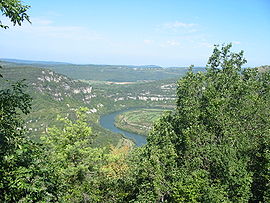Nantua
| Nantua | ||
|---|---|---|
 |
||
|
||
| Coordinates: 46°09′07″N 5°36′28″E / 46.1519°N 5.6078°ECoordinates: 46°09′07″N 5°36′28″E / 46.1519°N 5.6078°E | ||
| Country | France | |
| Region | Auvergne-Rhône-Alpes | |
| Department | Ain | |
| Arrondissement | Nantua | |
| Canton | Nantua | |
| Government | ||
| • Mayor (2014–2020) | Jean-Pierre Carminati | |
| Area1 | 12.79 km2 (4.94 sq mi) | |
| Population (2014)2 | 3,534 | |
| • Density | 280/km2 (720/sq mi) | |
| Time zone | CET (UTC+1) | |
| • Summer (DST) | CEST (UTC+2) | |
| INSEE/Postal code | 01269 /01130 | |
|
1 French Land Register data, which excludes lakes, ponds, glaciers > 1 km² (0.386 sq mi or 247 acres) and river estuaries. 2Population without double counting: residents of multiple communes (e.g., students and military personnel) only counted once. |
||
1 French Land Register data, which excludes lakes, ponds, glaciers > 1 km² (0.386 sq mi or 247 acres) and river estuaries.
Nantua (French pronunciation: [nɑ̃tɥa]) is a commune and subprefecture in the Ain department in eastern France. The usual demonym for its inhabitants is Nantuatien(ne); however, they are also sometimes called Catholards, after a needle used by leatherworkers. Indeed, Nantua has long been a town of tanners and shoemakers.
The town grew up around a Benedictine Monastery founded in 671 by St. Amand and the church of St Peter where the body of Charles the Bald was initially buried.
The Priory of Nantua was sacked and burned in 1230 by Etienne I of Thoire-Villars. Later, Boniface of Savoy, Archbishop of Canterbury was selected Prior of Nantua in 1232.
Nantua faces a small lake on its west side and is protected by high cliffs on its landward sides which gives rise to a relatively mild continental climate.
Nantua is twinned with:
...
Wikipedia



